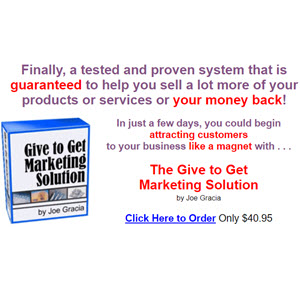High octane 2 Concentrate on the best customers
The invention of the computer has made a certain well-known and explosive marketing strategy work better than ever. Today, all modern retail stores, supermarkets, and many other kinds of businesses, capture specific points of information about each customer sold by entering sales data into a computer. If the computer is programmed to do so, it will automatically record the vital buying behaviour patterns of each customer - patterns which you can analyze and use to make a lot more money while wasting a lot less time.
After a few months of business, you can examine your customer data and find some amazing facts. Certain customers will show up to be your best - that is, they come in more often, they spend more, and they have preferences for specific products. Other customers can be shown to be less valuable - they come in less, spend less, and may also complain more and ask for refunds more often.
Knowing which customers are good and which are not so good is a golden opportunity to dramatically improve your profits, while at the same time, decrease what you spend on marketing.
It's as simple as this: concentrate your advertising and marketing on the good customers, and drop or spend less on the bad customers. You can afford to spend more money on good customers because you already know they are a good investment. You can feel comfortable spending less or nothing at all on bad customers because they don't support your business very well in the first place.
Let's say you are planning a direct mail campaign, and you're using the names of your captured customers for a mailing list. In the 'Old World' you might send a sales letter with discount coupon to every name on the list. Many of those names will be those of customers who are, frankly, more trouble than they are worth. But because you are blind about who's good and who's bad, you have to send to everybody and hope for the best.
But when you have hard data that shows clearly the good customers, you can send your costly marketing materials to them only, and forget the rest.
Also, your computer data can show not just how much your customers spend, but what they like to buy the most. Let's say you own a grocery store. All experienced grocers know that they make little or no money on some items, and make a high profit percentage on other items. But grocers realize they must carry the low-profit items because people still want to buy them, and thus, it brings customers into the store. While they're in the store, the grocer hopes the better paying items will catch the eye of the shopper and they'll buy. Grocers also put certain items on sale, and accept a lower profit, or even a break-even situation, as a way to tease more customers into the store. The hope is they'll buy non-sale items while they're in the store. The problem is that this is a shotgun approach. The grocer has no control. They hope the sales seekers will buy some high-profit items while in the store, but there's no guarantee. Grocers just hate what they call 'cherry pickers.' These are people who watch for sales, and come in only to buy sales items. When grocers concentrate on putting on sales, what they're really doing is catering to lower quality customers'. A sale attracts the cherry pickers like flies - but what about the big spenders? Now those are the people they really want'.
Well, when you have specific computer data, you can easily tell who comes in to buy the highest profit items the most often. Then, instead of losing cash on sales, you can direct very specific, targeted marketing messages at the big spenders, enticing them to come in and buy more—and to hell with the cherry pickers'. The best way to do this is with direct mail. For example, let's say you have identified 300 customers who buy a lot of steaks. It's a high profit product, and now you know who likes them most. All that's left to do is concentrate steak selling messages on frequent buyers with direct mail and you get the best of all worlds - high spending customers buying high profit items!
Also, treating your best customers as 'preferred' customers is an excellent way to reward their buying behaviour. We have long known from basic psychology that when an animal is rewarded for certain behaviour, it will be more likely to repeat that behaviour. That includes humans, and that's the idea here. Reward your best customers by telling them you know they are your best! In your marketing material, you can say something like:
Dear Mrs. Jones
We realize that you are one of our best customers, and we just wanted to take this opportunity to thank you for your continued support of our business. As a gesture of our appreciation, please find enclosed a coupon for a 20% discount on (favourite product here) ...
Furthermore, make sure you let your high quality customer know that they are not only a preferred customer, but that there are many other customers that are not getting the same deal! You want to make them feel exclusive and special. People just love to believe or know that they are privileged in some way. This is one small way you can give them that very feeling.
You can afford to offer high quality customers a discount because you know they'll continue to spend at higher levels, making up your discount in future sales.
No matter what kind of business you are in, and even regardless if you use a computer or not, you can stop wasting time and start making more money by concentrating on your best customers. Why cater to cheapskates with sales, when you can build a 'preferred customer' list with targeted marketing?
One final thing: ask your computer or software dealer for programs which capture and analyze customer data easily and effortlessly. The computer has made concentrating on the best customers more easy than ever. You'd be crazy not to pick up this easy-to-use technology and put it to work for you. The difference it can make in your profit margin can—and will be—truly astounding!
Continue reading here: Never underestimate the intelligence of the buyer
Was this article helpful?


